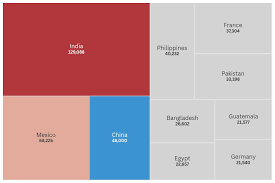China secured only 5.3% of global remittances in 2024, its lowest share in at least two decades.
In 2024, India received an estimated $129.1 billion worth of remittances, the highest ever for a country in any year. Moreover, India’s share in global remittances was 14.3% this year, the highest such share since the turn of the millennium for any country. The conclusions are based on a blog article published last week by the World Bank.
Remittances refer to the money that individuals working abroad send back to support their families in their home country. They are often a crucial source of income for households in developing countries and can contribute significantly to the economy of the recipient country.
Following India, Mexico and China received the largest remittances in 2024.
Chart 1 shows the top 10 receivers of remittances in $ million in 2024.

The Philippines, France, Pakistan, Bangladesh, Egypt, Guatemala, and Germany are the other countries on the list. While China was third on the list, past years’ numbers provide interesting insights.
Chart 2 shows the share of global remittances for the top 10 countries mentioned in Chart 1 in the 2000-2024 period.

China’s share of remittances grew from less than 1% in the early 2000s to over 10% by the late 2000s and early 2010s, matching India’s numbers, before gradually declining to below 10% in the late 2010s.
From 2020, the share declined rapidly reaching a two-decade low of 5.3% in 2024. According to the World Bank, China’s rising economic prosperity and an ageing population slowed the pace of emigration of less-skilled people, which contributed to this decline.
India’s share has remained above the 10% mark for most of the years since 2000, with few exceptions. In fact, in the post-pandemic years, there has been a rapid increase in its share. India’s share in global remittances was twice the share of Mexico’s in 2024 (7.5%); Mexico was a distant second.
Though India leads in absolute remittance inflows, in some economies, remittances play a more critical role in funding current account deficits and fiscal shortfalls.
To better understand this, Chart 3 depicts estimated remittances in 2024 as a share of a country’s GDP. Each circle is a country. The farther the circle is to the right, the higher the remittance in 2024 as a share of GDP. The bigger the circle, the higher the remittance in 2024 in absolute figures.

In Nepal, remittances formed over 25% of the GDP in 2024. In Tajikistan, Nicaragua, Lebanon, Samoa, Honduras, and Tonga, the share of remittances in 2024 formed over 25% of their respectives GDPs. In India, remittances formed 3.3% of the GDP this year.
For many low-and middle-income countries, remittances act as a major source of income. In 2024, these countries received $685 billion as remittances, the highest ever in a year. According to the blog, remittances to these countries have consistently outpaced other types of external financial flows.
In recent years, remittances have even surpassed Foreign Direct Investment (FDI) in low-and middle-income countries put together. FDIs are investments by a foreign country to control or run a business in another country. Remittances are also much higher than the official development assistance (ODA) received by these countries. ODA is the aid from rich countries to help poorer ones develop, often through grants or cheap loans.
Chart 4 compares remittances, FDI, and ODA received by low-and middle-income countries between 2000 and 2024.
Over the past decade, remittances increased by 57% while FDI declined by 41% in low-and middle-income nations, the blog notes.
Source: The data for the charts were sourced from a blog article published by the World Bank on December authored by Dilip Ratha, Sonia Plaza and Eung Ju Kim
vignesh.r@thehindu.co.in
source/content: thehindu.com (headline edited)